Le Rouge, Faugues, Barbingant, Puyllois
Two Masses in SPB80 have extensive motivic connections with Masses preserved in other Italian manuscripts. The Missa So ys emprentid by Le Rouge and the Missa of Barbingant are part of a complex that also includes Faugues's Missa La basse danse and Johannes Puyllois's Missa .[12]
[12] I accept the attribution of this Mass to Puyllois. It has been questioned by Curtis, "Jean Pullois and the Cyclic Mass or a Case of Mistaken Identity." Motivically it has much in common with chansons and motets of Puyllois and Horlay (as shown below), the composer to whom Puyllois is linked in EscB. Margaret Bent also doubts Curtis's conclusion that this Mass has English origins ("Trent 93 and Trent 90: Johannes Wiser at Work," 92). For the spelling of "Puyllois," I follow Pamela Starr, "Music and Music Patronage at the Papal Court, 1447-1464," 167-75.
The correspondences proceed movement by movement, pairing successive head motives in the manner of a paraphrase; sometimes the order of motives is altered, as when the Patrem of Faugues's Missa La basse danse begins with a motive related to the Et in terra by Le Rouge.
The many resemblances between the Masses in this complex are detailed in Tables 15 and 16, and also in Examples 2 and 3. Table 15 views the shared motives from the standpoint of how they relate to Le Rouge's Missa So ys emprentid , first in a composite listing, then itemized one Mass at a time. Asterisks mark motives that appear with the same text (for the purposes of this table and the next, the separate Kyrie and Agnus sections are considered to be different texts). The Faugues and Barbingant Masses have approximately the same number of motives in common with the Le Rouge Mass, each with more than twice the number of similarities found in the Puyllois Missa . Counting only those motives that appear with the same texts, the remarkable ties between the Masses by Le Rouge and Faugues involve the Patrem, Et incarnatus, Pleni, Benedictus, and Agnus II; these overlap slightly with the six beginnings common to Le Rouge and Barbingant: the Christe, Et in terra, Laudamus te, Patrem, Sanctus, and Agnus II.
Some of these motivic similarities between Le Rouge, Faugues, and Barbingant are shown in Example 2. Normally they involve two voices at the beginning of a section; only Example 2e is from a conclusion. In Example 2h the motivic resemblance is also harmonic: this is the only section of the Agnus to begin on a rather than d in both Masses. At the start of the Qui sedes, Faugues also introduces the same imitative motive that begins the second half of Le Rouge's chanson Se je fayz dueil (Ex. 2i), a resemblance discussed in chapter 10.
A slightly different picture emerges from Table 16, which compares the other Masses to Barbingant's Missa . Barbingant has equally strong resemblances to the Masses by Le Rouge and Puyllois, with ten and nine correspondences respectively. Most movements in the Barbingant Mass start with a motive that also begins the same section of one of these two Masses. Thus Barbingant's Kyrie I shares its head motive with the Kyrie I by Puyllois (Ex. 3a), the Et in terra with the Le Rouge Et in terra (Ex. 2b), and the Patrem with the Le Rouge Patrem; the Sanctus and Agnus both relate to the motive that begins the Puyllois Patrem (the comparisons are in Exs. 3b and c). Because of these ties to
EXAMPLE 2. Motivic comparison of Faugues, Missa La basse danse , Le Rouge, Missa So ys emprentid , and Barbingant, Missa
EXAMPLE 2A . (i) Faugues, Christe, min. 1-5; (ii) Le Rouge, Cum sancto, ram. 1-3; (iii) Barbingant, Christe, min. 1-4
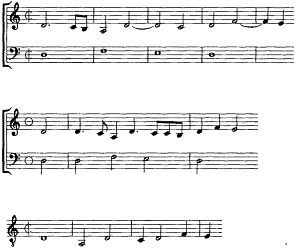
EXAMPLE 2B . (i) Faugues, Patrem, mm. 1-6; (ii) Le Rouge, Et in terra, min. 1-4; (iii) Barbingant, Et in terra, mm. 1-5
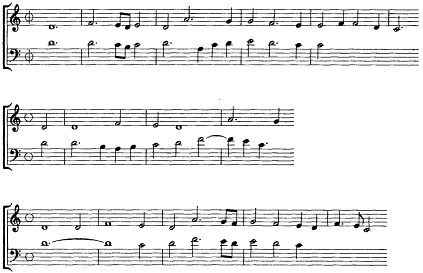
(continued )
EXAMPLE 2 (continued )
EXAMPLE 2C . (i) Faugues, Crucifixus, mm. 1-7; (ii) Le Rouge, Et in spiritum (SPB80), Et incarnatus (Tr90), mm. 1-3; (iii) Barbingant, Christe, mm. 1-7
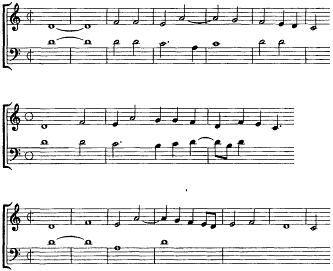
EXAMPLE 2D . (i) Faugues, Pleni, min. 1-5; (ii) Le Rouge, Pleni, mm. 1-3; (iii) Barbingant, Benedictus, mm. 1-7
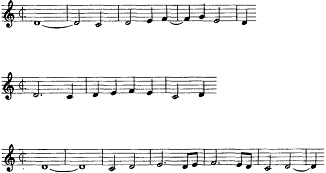
(continued )
EXAMPLE 2 (continued )
EXAMPLE 2E . (i) Faugues, Pleni, mm. 16-20; (ii) Le Rouge, Pleni, mm. 25-30

EXAMPLE 2F . (i) Faugues, Benedictus, mm. 1-9; (ii) Le Rouge, Benedictus, min. 1-4, 5-6
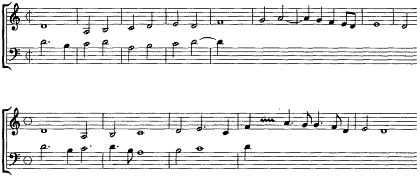
(continued )
EXAMPLE 2 (continued )
EXAMPLE 2G . (i) Faugues, Agnus II, mm. 1-4; (ii) Le Rouge, Agnus II, mm. 1-5; (iii) Barbingant, Agnus II, mm. 1-3; (iv) Puyllois, Missa , Agnus II, mm. 1-4
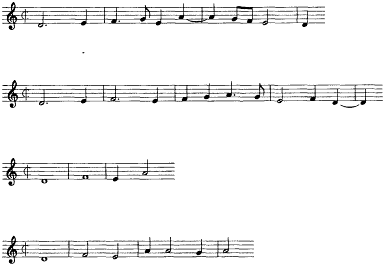
EXAMPLE 2H . (i) Faugues, Agnus I, min. 1-3; (ii) Barbingant, Agnus III, min. 1-4
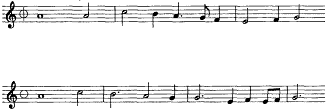
EXAMPLE 2I . (i) Faugues, Qui sedes, mm. 9-15; (ii) Le Rouge, Se je fayz dueil , part 2
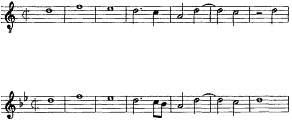
Barbingant and Puyllois, Le Rouge could not have been solely dependent on Faugues. There is also evidence that Faugues was not exclusively indebted to Le Rouge: While all of the motives that Faugues shares with Barbingant's Missa are also present in Le Rouge's Mass, Faugues is more likely than Le Rouge to have motives with the same text set by Barbingant.
A partial measure of the many similarities between the Puyllois Missa and the Masses by Barbingant and Le Rouge is shown in Example 3. The head motive in the Puyllois Mass does not remain constant. After the Kyrie I, which begins d-f-e-c and then winds its way up to a', Puyllois transforms the motive in various ways, either by preceding the four opening pitches with f (Ex. 3b) or d-f (Ex. 3c) or by following them with a descent to the lower a (Ex. 3e). In the Sanctus the motive that begins on d and then descends from f to a is varied from one section to the next. Most of the motivic permutations that occur in the Puyllois Missa also occur in the Barbingant Missa , in essentially the same sequence. But while Puyllois spreads his throughout each movement of the Mass, Barbingant concentrates them in the Kyrie, Sanctus, and Agnus (the other movements having stronger resemblances to the Le Rouge Mass).
All four Masses in this cluster relate motivically at the head motive of the Agnus II (Ex. 2g). Despite the commonplace character of this ubiquitous d-f-e-a' motive, the coincidence of variants on this motive at the same text, in four Masses with numerous other motivic ties, is less likely to be a matter of chance. Among all the many other instances of this motive in Masses, only in the fifth Naples Missa L'homme armé does it occur at the Agnus II, there transposed to begin on G.
Who followed whom? Faugues and Barbingant both seem to depend heavily on Le Rouge. Stylistically Faugues's Mass is certainly later than the Missa So ys emprentid . In terms of length it extends far beyond the dimensions of that by Le Rouge. The entire Kyrie I, Christe, and Kyrie II of the Missa So ys emprentid last for forty-six breves of tempus perfectum , as opposed to forty-six breves in tempus perfectum diminutum for just the Kyrie II in Faugues's Mass. Barbingant's Missa , equally linked to Le Rouge and Puyllois, is transmitted in the second layer of SPB80 and in Tr89, with repertoires closer in date to those of CS51 and Tr91, the sources of the Missa La basse danse . Of the
EXAMPLE 3. Motivic comparison of Puyllois, Missa , Barbingant, Missa , and Le Rouge, Missa So ys emprentid
EXAMPLE 3A . (i) Puyllois, Kyrie I, mm. 1-4; (ii) Barbingant, Kyrie I, mm. 1-5; (iii) Puyllois, Et in terra, mm. 1-5
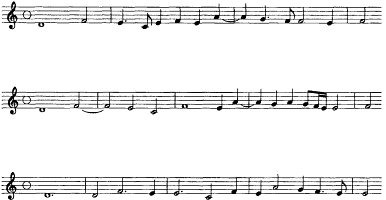
EXAMPLE 3B . (i) Puyllois, Qui sedes, mm. 10-15; (ii) Barbingant, Agnus I, mm. 1-4
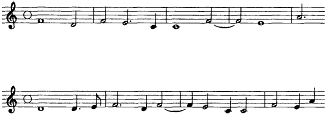
EXAMPLE 3C . (i) Puyllois, Patrem, mm. 1-4; (ii) Barbingant, Sanctus, mm. 1-5
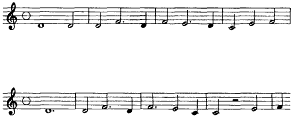
(continued )
EXAMPLE 3 (continued )
EXAMPLE 3D . (i) Puyllois, Domine Fill unigenite, min. 1-4; (ii) Le Rouge, Osanna I, ram. 1-4

EXAMPLE 3E . (i) Puyllois, Sanctus, mm. 1-4; (ii) Le Rouge, Sanctus, mm. 1-3; (iii) Puyllois, Kyrie I, mm. 14-17; (iv) Barbingant, Pleni, mm. 11-13
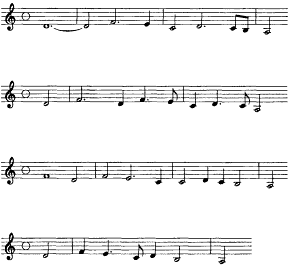
Masses by Le Rouge and Puyllois, that by Puyllois seems to be the older, but this is by no means certain. These four Masses therefore apparently fall into two chronological pairs, an early one of Puyllois and Le Rouge, and a slightly later one (perhaps fifteen years) of Faugues and Barbingant.
A previously unrecognized secular source of the Puyllois Missa sug-
gests an additional link to Le Rouge and Barbingant. Although Puyllois may have cited more than one chanson in his Missa , he draws extensively on Puisque je suis infortunée by Horlay, a composer closely associated with Puyllois in the chansonnier Escorial.[13] The chanson is particularly evident in the Sanctus. From the opening motive (Ex. 4a) through the mid-point of the chanson, each phrase is present in the Missa . Examples 4b and c show consecutive phrases of the chanson and Sanctus with cadential counterpoint that is at times identical. The me-dial cadence with its falling third in the superius then follows in the chanson (Ex. 4d). Both voices appear in the Qui tollis and at the end of the Qui ex patre, altered there to include a cadence on d rather than e. The bass melodic figure, marked "x," and the rhythms are identical. And the Qui tollis has a simplified version with both voices in duple meter.[14] In the Kyrie II there is a noncadential

Textually the Horlay chanson is close both in theme and rhyme to the chansons Terriblement suis fortunée and Pour une suis desconfortée . In each the poet blames his lack of fortune on the rejection of a lover, with rhyming verses on the word abandonée :
Puisque je suis infortunée, (line 1)
Et de m'amour abandonée ... (line 2)
Pour une suis desconfortée... (line 1)
Pour ce que suis abandonée ... (line 3)
Terriblement suis fortunée ... (line 1)
M'a de tous poins abandonée ... (line 6)
While Terriblement suis fortunée is well known as the source of a Mass by Barbingant, Pour une suis desconfortée is the preferred French text to Frye's English ballade So ys emprentid .[15] Thus Puyllois, Barbingant, and
[13] Martha K. Hanen, The Chansonnier El Escorial IV. a. 24 , I: 80-81, and below, p. 225 n. 35.
[14] On the strength of the sharped c in the chanson, a ficta alteration in the Mass is reasonable.
[15] On the sources and texting, see Leeman Perkins and Howard Garey, The Mellon Chansonnier , 2:370-72; and Isabel Pope and Masakata Kanazawa, The Musical Manuscript Montecassino 871 , 567-68.
EXAMPLE 4. Motivic comparison of Horlay, Puisqueje suis infortunée and Puyllois, Missa
EXAMPLE 4A . (i) Horlay, mm. 1-3; (ii) Puyllois, Sanctus, mm. 1-4
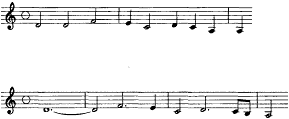
EXAMPLE 4B . (i) Horlay, mm. 8-10; (ii) Puyllois, Sanctus, mm. 12-17

EXAMPLE 4C . (i) Horlay, mm. 11-16; (ii) Puyllois, Sanctus, mm. 17-21
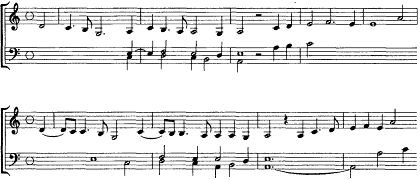
(continued )
EXAMPLE 4 (continued )
EXAMPLE 4D . (i) Horlay, ram. 14-19; (ii) Puyllois, Qui ex Patre, ram. 34-38; (iii) Puyllois, Qui tollis, mm. 37-47
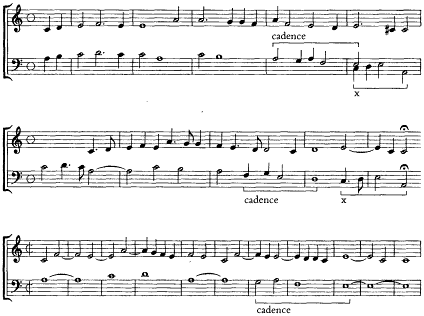
EXAMPLE 4E . (i) Horlay, mm. 25-28; (ii) Puyllois, Kyrie II, mm. 16-20

(continued )
EXAMPLE 4 (continued )
EXAMPLE 4F . (i) Horlay, mm. 1-3; (ii) Puyllois, Kyrie, mm. 1-4
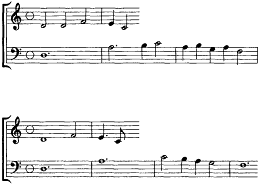
Le Rouge may each have written Masses based, at least in part, on chansons with a related message. That they probably did so within a few years of each other—on stylistic and paleographic grounds they have been dated circa 1450—increases the likelihood of some conscious emulation, an emulation also suggested by the other motivic ties between the Masses by Le Rouge and Puyllois and later by Barbingant and Faugues.[16]
From a purely musical standpoint, the motivic similarities between these four Masses demonstrate vividly that composers could emulate one another without reference to the tenor. While composing his Mass on a dance tune presented in the tenor, Faugues cited motives from
[16] Rob Wegman, "Petrus de Domarto's Missa Spiritus almus and the Early History of the Four-Voice Mass in the Fifteenth Century," 301, dates the Puyllois Missa ca. 1445 on the basis of its appearance in Tr87. However, Bent suggests that the Tr87 copy of this Mass was made from that in Tr93 on the basis of "errors shared between the two copies, and some deteriorations in the otherwise neater Tr 87 copy" ("Trent 93 and Trent 90," 90, n. 28). Saunders has dated the Tr93 copy at "1451, 1452" ("The Dating of Trent 93 and Trent 90," 73). That the Tr87 version could be later concurs with Gary R. Spilsted's hypothesis that the Tr87 fascicles that include the Mass, largely empty, were to "allow for further repertory to be added as it was needed" ("The Paleography and Musical Repertory of Codex Tridentinus 93," 56). He dated the watermark of this paper broadly at "ca . 1450 to ca . 1470" (75).
the Le Rouge Missa So ys emprentid in the contrapuntal voices, as did Barbingant. Without a doubt this kind of citation had textual meaning.